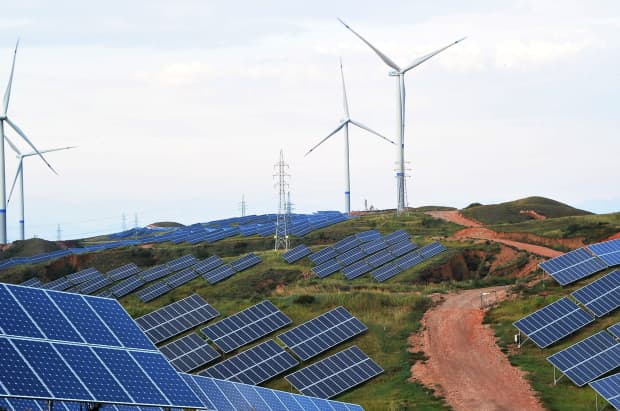# IEA crowns renewables ‘new king’ of world electricity markets as oil demand will flatten by 2030

Table of Contents
“#
IEA crowns renewables ‘new king’ of world electricity markets as oil demand will flatten by 2030
”
Despite the increase in solar and wind power, carbon emissions are projected to pick up in 2021

Solar panels and wind turbines are pictured on a barren mountain at Shenjing Village, China.
Oil demand will plateau in 2030 and drop from there, helping clear room for solar energy to become the “new king” of electricity generation.
That’s the assessment in recent days from the International Energy Agency, which said in its 2020 world energy outlook that a solar-lead surge in renewable power will help fossil-fuel alternatives account for 80% of growth in global electricity generation in the next decade.
The report takes on added significance because the IEA in the past has tended to downplay the role of renewables, said Miro Korenha and Monica Medina, writing in the Daily Planet newsletter.
Renewables are expected to overtake coal as the primary means of producing electricity in the world by 2025. But, the IEA added, fossil-fuel demand can’t be entirely counted out in large part because developing nations still want oil and gas.
What’s more, the coronavirus pandemic will cut global carbon emissions to a decade low this year, but rising long-term demand for fossil fuels in those developing nations means the world is on course to miss landmark climate targets absent more policy changes, the IEA report also said.
Peak crude oil demand has already been reached in “advanced economies” such as the U.S. and the European Union, but developing economies such as China and India will drive growing oil demand in the years ahead.
Emerging market oil demand will rise by 9 million barrels a day in the years to 2030, offsetting a drop in the developed world, the IEA said.
As for renewables, the combined share of solar photovoltaic (PV) and wind in global generation will rise to almost 30% in 2030 from 8% in 2019, the group said, with solar PV capacity growing by an average 12% a year.
Demand is being fed by maturing technology and financing support for major solar PV projects, the IEA said. Solar PV is now cheaper than new coal- or gas-fired power plants in most countries, it said.
A more ambitious policy scenario, such as the adoption of net-zero emissions targets by 2050, would see PV electricity generation perform even more strongly, the report said.
Despite the increase in solar and wind power, carbon emissions are projected to pick up in 2021 after a 2.4 gigatonne (Gt) drop in 2020, the IEA said.
That’s unsettling news for climate-change watchers given the latest temperature data to be released Wednesday.
Earth’s temps sweltered to a record hot September last month, with U.S. climate officials saying there’s nearly a two-to-one chance that 2020 will end up as the globe’s hottest year on record.
Boosted by human-caused climate change, global temperatures averaged 60.75 degrees last month, edging out 2015 and 2016 for the hottest September in 141 years of recordkeeping, the National Oceanic and Atmospheric Administration said.
This record was driven by high heat in Europe, Northern Asia, Russia and much of the Southern Hemisphere, said NOAA climatologist Ahira Sanchez-Lugo. California and Oregon, meanwhile, which both made headlines with devastating wildfires, had their hottest Septembers on record.
By
Rachel Koning Beals
For forums sites go to Forum.BuradaBiliyorum.Com
If you want to read more News articles, you can visit our News category.




